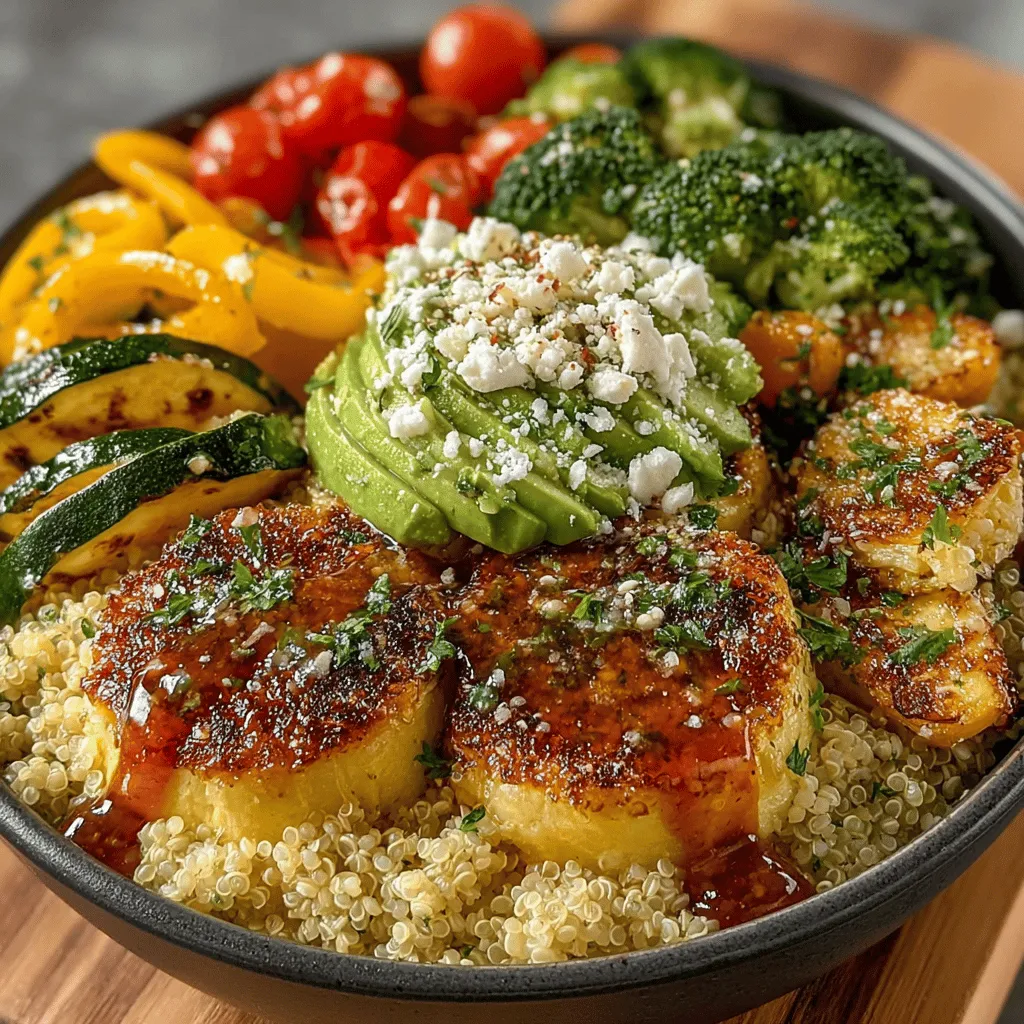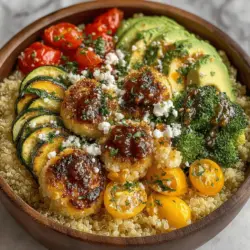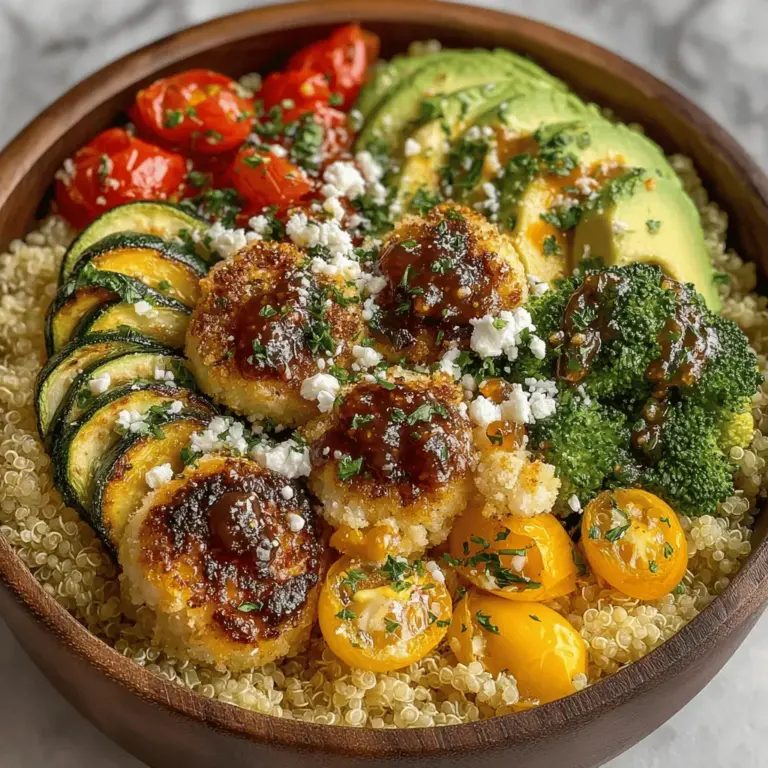Introduction: Embracing Nourishment with Quinoa and Roasted Veggie Power Bowls
In today’s fast-paced world, finding nutritious, delicious, and easy-to-make meals can be a challenge. As people become more health-conscious, the demand for recipes that are both satisfying and wholesome has surged. Quinoa and Roasted Veggie Power Bowls are a remarkable solution, providing not only a feast for the eyes with their vibrant colors but also a powerhouse of nutrients that fuel your body. These bowls are not just meals; they are a celebration of seasonal produce and wholesome grains, designed to nourish you from the inside out.
Quinoa, often lauded as a superfood, serves as the foundation of this dish, providing essential protein and fiber. Combined with an array of roasted vegetables, these power bowls become a medley of flavors and textures, perfect for lunch, dinner, or even meal prep for the week ahead. Whether you are vegetarian, vegan, or simply looking to incorporate more plant-based meals into your diet, this recipe is versatile and adaptable to suit a variety of tastes and dietary preferences.
In this article, we will explore the recipe for Quinoa and Roasted Veggie Power Bowls in detail. We will delve into the nutritional benefits of each ingredient, preparation techniques that enhance flavor, and serving suggestions that elevate this dish to new heights. Let’s embark on this culinary journey and discover how to create a bowl that is not only delicious but also nourishing.
The Nutritional Benefits of Quinoa and Roasted Vegetables
Understanding Quinoa: A Superfood
Quinoa (Chenopodium quinoa) is often referred to as a superfood for good reason. This ancient grain, originally cultivated in the Andean region of South America, boasts a remarkable nutritional profile. One of the standout features of quinoa is its high protein content. Unlike many other grains, quinoa is a complete protein, meaning it contains all nine essential amino acids that our bodies cannot produce on their own. This makes it an excellent choice for vegetarians and vegans seeking to meet their protein needs.
In addition to being a protein powerhouse, quinoa is rich in dietary fiber. Just one cup of cooked quinoa contains about 5 grams of fiber, which aids in digestion, promotes satiety, and helps regulate blood sugar levels. Furthermore, quinoa is gluten-free, making it suitable for individuals with gluten sensitivities or celiac disease. Its versatility in the kitchen allows it to be incorporated into a variety of dishes, from salads to soups, and of course, power bowls.
The Power of Roasted Vegetables
The true beauty of Quinoa and Roasted Veggie Power Bowls lies in the colorful array of vegetables that can be used. Common choices include zucchini, bell peppers, cherry tomatoes, red onions, and broccoli, each contributing unique flavors and health benefits. For instance, zucchini is low in calories and high in water content, making it a hydrating addition to your bowl. Bell peppers provide a wealth of vitamins A and C, while cherry tomatoes are packed with antioxidants like lycopene, which may support heart health.
Roasting these vegetables elevates their natural flavors, creating a sweet, caramelized taste that enhances the overall dish. The cooking process also helps retain essential nutrients, making roasted vegetables a delicious and healthful choice. Additionally, the use of healthy fats, such as olive oil, during roasting not only aids in flavor but also promotes the absorption of fat-soluble vitamins, further enhancing the nutritional profile of your meal.
Ingredients Breakdown: What You’ll Need for the Perfect Power Bowl
Core Ingredients for Quinoa and Roasted Veggie Power Bowls
To create your Quinoa and Roasted Veggie Power Bowls, you will need a selection of core ingredients that form the basis of this nourishing meal. Here’s what you’ll need:
1. Quinoa: The star of the dish, quinoa should be rinsed thoroughly to remove its natural coating, called saponin, which can give it a bitter taste.
2. Zucchini: This versatile vegetable can be sliced into rounds or cubes, offering a mild flavor that pairs well with other ingredients.
3. Bell Peppers: Choose a mix of colors—red, yellow, and green—for a vibrant bowl. Each color offers a different flavor profile and nutritional benefit.
4. Cherry Tomatoes: Their sweetness adds a bright contrast to the roasted vegetables, and they are rich in vitamins and antioxidants.
5. Red Onion: Adding a touch of sharpness, red onion caramelizes beautifully in the oven, enhancing the overall flavor of the dish.
6. Broccoli: A nutritional powerhouse, broccoli is high in vitamins K and C, and also provides fiber. Its crunchy texture adds a satisfying bite to the bowl.
These core ingredients work together to create a balanced and nutritious meal that is both filling and flavorful.
Optional Ingredients for Customization
One of the joys of preparing Quinoa and Roasted Veggie Power Bowls is the ability to customize them to suit your palate. Here are some optional ingredients you can consider adding:
– Avocado: Creamy and rich, avocado not only enhances the flavor of your bowl but also provides healthy monounsaturated fats and potassium.
– Feta Cheese or Vegan Cheese: A sprinkle of feta cheese adds a tangy element to your bowl, while vegan cheese options can provide a creamy texture for those following a plant-based diet.
– Tahini Dressing: This sesame seed paste is not only delicious but also packed with nutrients. A drizzle of tahini dressing adds creaminess and an extra layer of flavor. Alternatively, consider other dressing options like balsamic vinaigrette or a lemon-tahini blend.
Step-by-Step Instructions: Crafting Your Power Bowl
Prepping the Quinoa
The first step in crafting your Quinoa and Roasted Veggie Power Bowls is to prepare the quinoa. Rinsing the quinoa is crucial; it removes the saponins that can impart a bitter taste. Place the quinoa in a fine-mesh strainer and rinse under cold running water for a couple of minutes, stirring it gently to ensure all grains are rinsed.
Once rinsed, transfer the quinoa to a medium saucepan and add water or vegetable broth. The standard ratio is 1 cup of quinoa to 2 cups of liquid. Bring it to a boil over medium-high heat, then reduce the heat to low, cover, and let it simmer for about 15 minutes, or until the quinoa has absorbed all the liquid.
To achieve fluffy quinoa, avoid stirring it while it cooks. Once the cooking time is complete, remove it from heat and let it sit covered for an additional 5 minutes. Fluff it gently with a fork before serving to separate the grains.
Preparing the Roasted Vegetables
While the quinoa is cooking, you can focus on preparing the roasted vegetables. Start by preheating your oven to 425°F (220°C). This high temperature is ideal for roasting, as it allows the vegetables to caramelize and develop deep flavors.
Chop your chosen vegetables into bite-sized pieces. Aim for uniform sizes to ensure even cooking. In a large mixing bowl, combine the chopped zucchini, bell peppers, cherry tomatoes, red onion, and broccoli. Drizzle with olive oil and season with salt, pepper, and any desired herbs or spices, like garlic powder or Italian seasoning. Toss the vegetables until they are evenly coated.
Spread the seasoned vegetables in a single layer on a baking sheet lined with parchment paper. This helps with easy cleanup and prevents sticking. Roast the vegetables in the preheated oven for about 20-25 minutes, or until they are tender and slightly charred, stirring halfway through to ensure even cooking.
With the quinoa cooked and the vegetables roasting, you are well on your way to creating a nourishing and satisfying meal that is sure to please both your taste buds and your nutritional goals. Stay tuned for the next part of the article, where we will discuss how to assemble your power bowl, along with serving suggestions and variations to keep your meals exciting and delicious.

Creating the perfect Quinoa and Roasted Veggie Power Bowls involves more than just following a recipe; it’s about understanding the techniques that elevate the dish and make it a delightful experience for your palate. In this section, we will delve into cutting techniques, seasoning suggestions, roasting methods, assembly tips, flavor profiles, meal prep, and storage advice to ensure your power bowls are a colorful and nutritious success.
Cutting Techniques for Even Cooking
When it comes to preparing vegetables for roasting, uniformity is key. Cutting vegetables into similar sizes ensures that they cook evenly and achieve that delightful caramelization. Here are some effective cutting techniques:
1. **Julienne:**
For vegetables like bell peppers and zucchini, cutting them into thin strips allows them to roast quickly and evenly. Aim for about 1/4 inch in width.
2. **Dice:**
Cubing vegetables such as sweet potatoes and carrots into 1-inch pieces promotes even cooking and maximizes surface area for caramelization.
3. **Slice:**
For onions and mushrooms, slicing them into even rounds or half-moons can enhance their flavor profile and allow for better browning.
4. **Chop:**
Roughly chopping leafy greens like kale or spinach will help them wilt nicely when added to the bowl, blending well with the other ingredients.
By mastering these cutting techniques, you’ll ensure that your veggies roast perfectly, resulting in a colorful and texturally pleasing power bowl.
Seasoning Suggestions for Maximum Flavor
The right seasoning can transform your roasted vegetables from simple to sensational. Here are some suggestions:
1. **Salt and Pepper:**
The basics are essential. A generous sprinkle of salt enhances the natural flavors of the vegetables, while freshly cracked black pepper adds a touch of warmth.
2. **Herbs:**
Dried herbs like oregano, thyme, and rosemary pair beautifully with roasted vegetables. Fresh herbs, such as parsley and cilantro, can be added at the end to brighten the dish.
3. **Spices:**
Experimenting with spices can elevate your bowl. Consider cumin for a warm, earthy flavor or paprika for a smoky touch. A pinch of cayenne can add a kick if you like heat.
4. **Citrus Zest:**
A sprinkle of lemon or lime zest just before serving brightens the dish, adding a refreshing note that complements the roasted flavors.
Roasting Techniques
The Science Behind Roasting Vegetables
Roasting vegetables involves cooking them in dry heat, which causes the sugars in the vegetables to caramelize, enhancing their sweetness and flavor. The high heat also promotes the Maillard reaction, which gives roasted veggies their appealing brown crust. Here are some tips to harness this science effectively:
Tips for Achieving the Perfect Caramelization
1. Preheat Your Oven:
Always preheat your oven to ensure that the vegetables start roasting immediately upon being placed inside. This helps in achieving that golden-brown finish.
2. Don’t Overcrowd the Pan:
Spread the vegetables out in a single layer on the baking sheet. Overcrowding can cause steaming rather than roasting, which prevents caramelization.
3. Use High Heat:
Roasting at a temperature of 425°F to 450°F allows for optimal caramelization without drying out the vegetables.
4. Toss Halfway:
Turning the vegetables halfway through roasting promotes even browning and prevents one side from becoming too dark.
Assembling Your Power Bowls
Layering and Presentation Tips
The presentation of your power bowl is just as important as its taste. Here’s how to assemble it beautifully:
1. Start with Quinoa:
Spoon a generous portion of quinoa into the bottom of your bowl. This will serve as the base and provide a hearty foundation.
2. Add Roasted Vegetables:
Layer the roasted veggies on top of the quinoa, arranging them in a visually appealing manner. Mix colors and textures for a feast for the eyes.
3. Include Fresh Greens:
Add a handful of fresh greens like spinach, arugula, or kale on top. The contrast between the warm roasted veggies and the fresh greens can elevate the dish.
4. Top It Off:
Finish with a sprinkle of seeds, nuts, or crumbled cheese for added texture, followed by a drizzle of your favorite dressing.
Customizing Each Bowl for Different Tastes
One of the best features of power bowls is their versatility. Here’s how to customize them:
– Protein Options: Consider adding grilled chicken, chickpeas, or tofu for additional protein.
– Flavor Boosts: Incorporate different sauces or dressings, such as tahini, hummus, or a spicy sriracha sauce, to cater to varying taste preferences.
– Seasonal Variations: Change the vegetables based on what’s in season or available at your local market. This not only keeps the recipe fresh but also ensures you are using the best ingredients.
Flavor Profiles: Enhancing Your Quinoa and Veggie Bowls
Seasoning Suggestions Beyond the Basics
To take your quinoa and veggie bowls to the next level, consider these advanced seasoning options:
1. Curry Powder: This blend can add a warm, exotic flavor to your roasted veggies, especially potatoes and cauliflower.
2. Za’atar: This Middle Eastern spice blend can introduce a tangy, herbal note to your dish, especially when paired with roasted eggplant or tomatoes.
3. Chili Flakes: For an extra kick, sprinkle some chili flakes on your veggies before roasting for a spicy surprise.
The Impact of Fresh Herbs
Fresh herbs can bring vibrancy to your power bowls. Here’s how to use them effectively:
– Parsley: Adds a fresh, peppery flavor. Chop it finely and sprinkle on top just before serving.
– Cilantro: Perfect for a refreshing twist, especially when paired with lime dressing.
– Basil: Adds a sweet and aromatic touch, ideal for Mediterranean-inspired bowls.
Dressing Options to Complement Your Bowl
The right dressing can transform the entire flavor profile. Explore these options:
1. Lemon Tahini Dressing: Creamy and tangy, this dressing pairs beautifully with roasted vegetables.
2. Balsamic Vinaigrette: A classic choice, the sweetness of balsamic vinegar works well with the earthy flavors of quinoa and veggies.
3. Spicy Peanut Sauce: Perfect for an Asian-inspired twist, this sauce offers a rich and nutty flavor that complements roasted veggies.
Homemade vs. Store-Bought Dressings: Pros and Cons
– Homemade Dressings: These allow you to control the ingredients and tailor flavors to your liking. They can be fresher and free from preservatives.
– Store-Bought Dressings: Convenient and quick, but may contain added sugars and preservatives. Look for brands with clean ingredient lists if you choose this route.
Meal Prep and Storage: Making Your Power Bowls Last
Preparing in Advance for Busy Days
Meal prepping your power bowls can save time during the week. Here’s how to do it effectively:
1. Batch-Cook Quinoa: Prepare a large batch of quinoa at once, then portion it out into individual containers for easy assembly throughout the week.
2. Roast Vegetables in Batches: Roast a variety of vegetables and store them in the fridge. This way, you can mix and match different flavors and textures during the week.
3. Store Components Separately: Keep quinoa, veggies, and dressing in separate containers to maintain freshness and prevent sogginess.
Reheating Tips
When reheating your power bowls, it’s essential to preserve flavor and texture:
1. Use the Oven: Reheat your bowls in the oven at a low temperature (around 350°F) for about 10-15 minutes to warm them through without drying out.
2. Microwave Wisely: If using a microwave, cover the bowl with a damp paper towel to retain moisture. Heat in short bursts, stirring in between to ensure even warming.
3. Transform Leftovers: Get creative with leftovers by turning them into stir-fries, wraps, or adding them to soups for a completely new dish.
Conclusion: A Colorful, Nutritious Meal for Any Occasion
Quinoa and Roasted Veggie Power Bowls are not only a feast for the eyes but also a nourishing meal option that can easily be adapted to suit any dietary preference. With a simple preparation process and an array of vibrant ingredients, these bowls become a versatile addition to your culinary repertoire. Embrace the wholesome flavors and health benefits of this delightful dish, and enjoy the satisfaction of creating a meal that is as good for your body as it is for your taste buds.
By mastering the art of cutting, seasoning, roasting, and assembling your power bowls, you can create a nutritious meal that stands out for its flavors, textures, and visual appeal. Whether for a busy weekday lunch or a relaxed weekend dinner, these power bowls are sure to impress and satisfy. So gather your ingredients, unleash your creativity, and relish in the deliciousness of your homemade Quinoa and Roasted Veggie Power Bowls!


